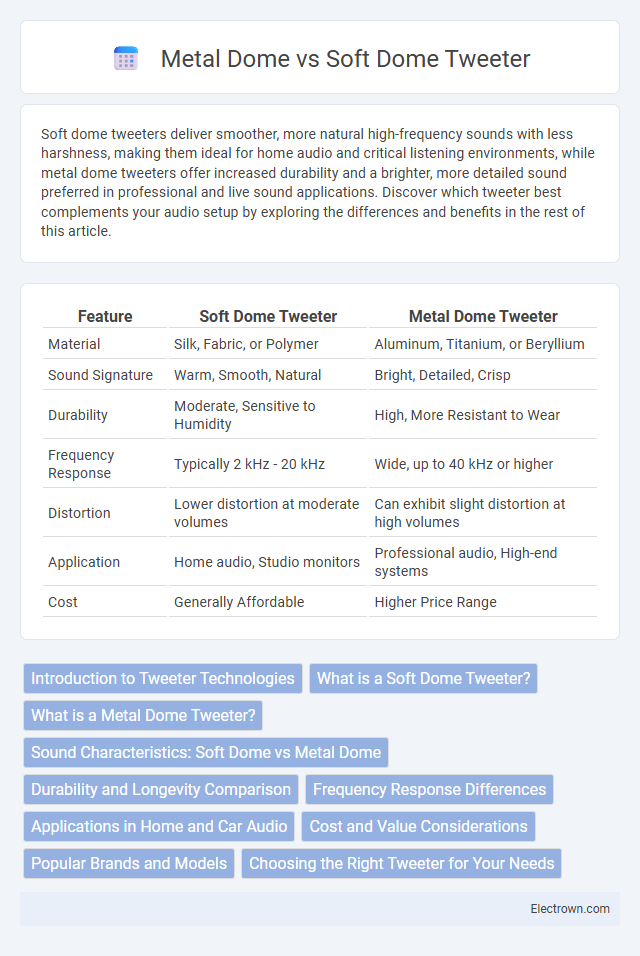Soft dome tweeters deliver smoother, more natural high-frequency sounds with less harshness, making them ideal for home audio and critical listening environments, while metal dome tweeters offer increased durability and a brighter, more detailed sound preferred in professional and live sound applications. Discover which tweeter best complements your audio setup by exploring the differences and benefits in the rest of this article.
Table of Comparison
| Feature | Soft Dome Tweeter | Metal Dome Tweeter |
|---|---|---|
| Material | Silk, Fabric, or Polymer | Aluminum, Titanium, or Beryllium |
| Sound Signature | Warm, Smooth, Natural | Bright, Detailed, Crisp |
| Durability | Moderate, Sensitive to Humidity | High, More Resistant to Wear |
| Frequency Response | Typically 2 kHz - 20 kHz | Wide, up to 40 kHz or higher |
| Distortion | Lower distortion at moderate volumes | Can exhibit slight distortion at high volumes |
| Application | Home audio, Studio monitors | Professional audio, High-end systems |
| Cost | Generally Affordable | Higher Price Range |
Introduction to Tweeter Technologies
Soft dome tweeters deliver smooth, natural sound with excellent high-frequency response, using a lightweight fabric diaphragm coated for durability. Metal dome tweeters provide brighter, more detailed sound by utilizing rigid materials like aluminum or titanium, offering higher sensitivity and extended frequency range. Your choice depends on audio preferences, as soft domes emphasize warmth and musicality, while metal domes enhance clarity and precision in high-frequency reproduction.
What is a Soft Dome Tweeter?
A soft dome tweeter features a diaphragm made from flexible materials like textile, silk, or polymer, allowing smooth and natural high-frequency sound reproduction with reduced harshness. Its lightweight design improves transient response, enhancing audio clarity and detail in your sound system. These characteristics make soft dome tweeters ideal for home audio setups seeking warm and balanced treble performance.
What is a Metal Dome Tweeter?
A metal dome tweeter uses a thin, rigid dome made from materials like aluminum, titanium, or beryllium to produce high-frequency sounds with precise detail and extended treble response. These tweeters are known for their durability, high sensitivity, and ability to handle high power levels without distortion. Your choice of a metal dome tweeter can significantly enhance clarity and brightness in audio playback compared to softer dome materials.
Sound Characteristics: Soft Dome vs Metal Dome
Soft dome tweeters produce a warm, smooth sound with natural midrange clarity and less harshness, favored for vocal and acoustic music reproduction. Metal dome tweeters offer a brighter, more detailed high-frequency response with greater sensitivity and extended frequency range, ideal for genres requiring crisp, precise treble. The choice between soft and metal domes hinges on listener preference for warmth versus brightness in high-frequency sound quality.
Durability and Longevity Comparison
Soft dome tweeters offer flexibility and resistance to high-frequency distortion but tend to be less durable over time due to material wear and environmental factors like humidity and UV exposure. Metal dome tweeters, often made from aluminum or titanium, provide superior durability and longevity, maintaining structural integrity and consistent sound performance under prolonged use and harsher conditions. Their rigid construction enables metal dome tweeters to withstand higher power levels and mechanical stress, making them a preferred choice for long-term reliability in demanding audio applications.
Frequency Response Differences
Soft dome tweeters typically deliver a smoother, warmer frequency response with enhanced midrange clarity, making them ideal for vocals and acoustic instruments. Metal dome tweeters offer a wider frequency range and higher sensitivity, producing brighter, more detailed highs that extend beyond 20 kHz. The choice between soft and metal dome tweeters depends on the desired tonal balance and application in audio systems.
Applications in Home and Car Audio
Soft dome tweeters offer smooth, natural sound ideal for home audio systems where warmth and clarity enhance music enjoyment. Metal dome tweeters provide higher rigidity and increased high-frequency dispersion, making them suitable for car audio environments that demand durability and precise sound projection. Your choice depends on whether you prioritize cozy, detailed sound at home or robust, clear output for dynamic in-car listening experiences.
Cost and Value Considerations
Soft dome tweeters generally offer more affordable pricing due to lower manufacturing costs, making them a cost-effective choice for budget-conscious audio systems. Metal dome tweeters, while typically more expensive, provide enhanced durability and higher frequency response, delivering greater audio fidelity that justifies the premium price for audiophiles. Evaluating cost and value considers application needs, with soft domes favoring cost efficiency and metal domes providing long-term investment in sound quality.
Popular Brands and Models
Popular soft dome tweeters include the Scan-Speak Revelator and SEAS Excel series, known for smooth and natural sound reproduction. Metal dome tweeters, such as the Morel Supremo and Scan-Speak D3004 models, offer enhanced durability and extended high-frequency response. Both types are favored by audiophiles, with soft domes excelling in warmth and metal domes providing clarity and detail in high-end audio systems.
Choosing the Right Tweeter for Your Needs
Soft dome tweeters offer smooth, natural sound with reduced harshness, making them ideal for home audio systems and music listening where warmth and clarity are prioritized. Metal dome tweeters excel in durability and high-frequency response, delivering bright, detailed audio preferred in professional sound setups and environments demanding precision. Understanding your audio environment and listening preferences guides the choice between soft dome's warmth and metal dome's crispness.
soft dome vs metal dome tweeter Infographic

 electrown.com
electrown.com